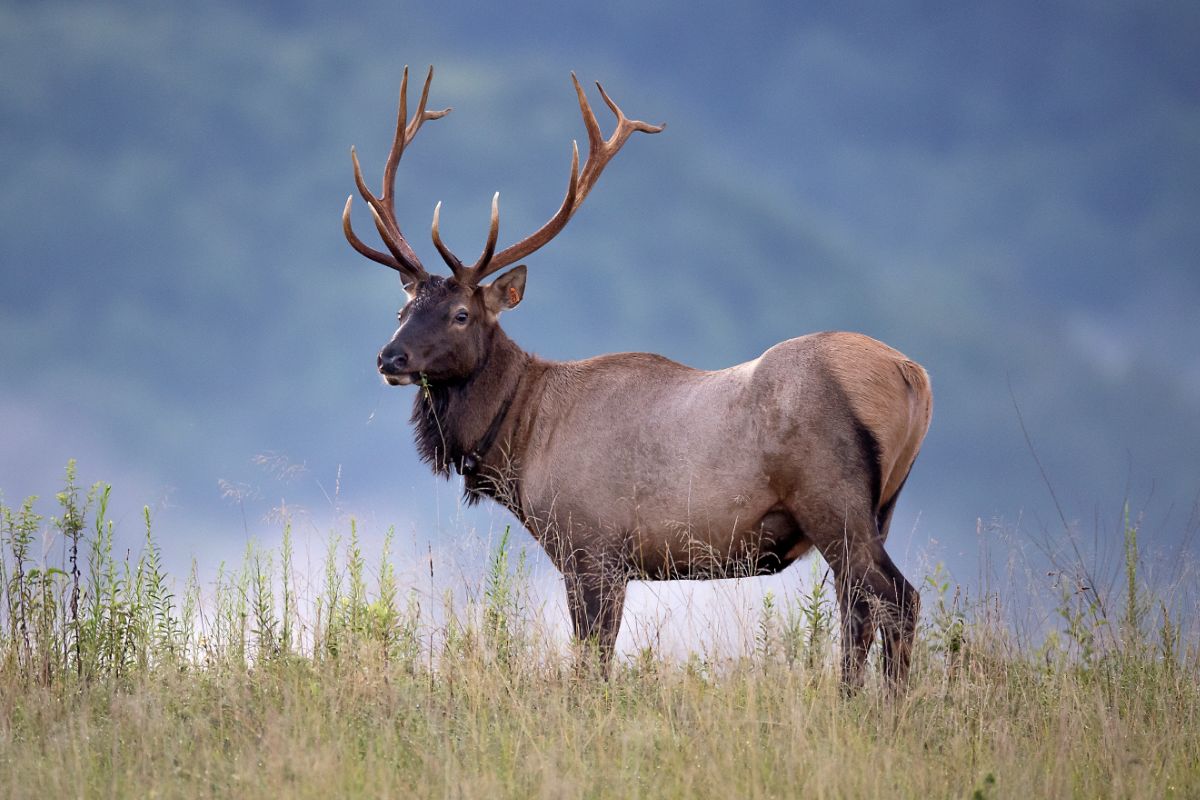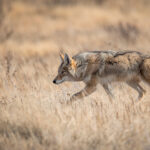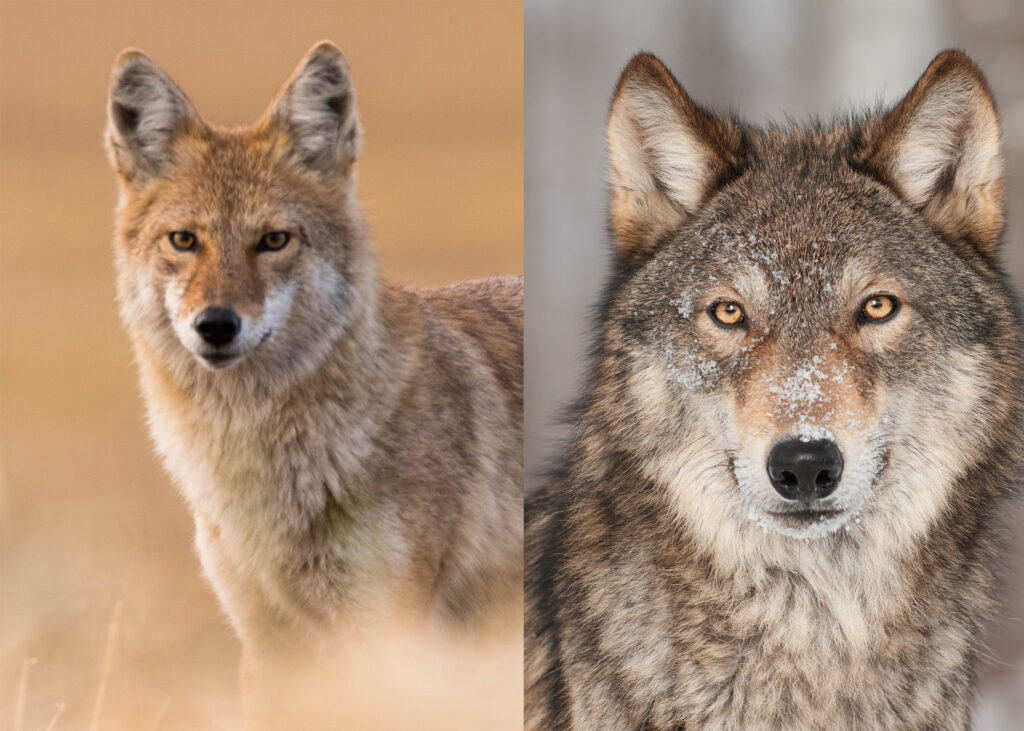
Although coyotes and wolves share similarities and belong to the same biological family, Canidae, they have many differences.
The main differences between coyotes and wolves include aspects of their size, diet, and habitat. Coyotes are smaller and thinner than wolves, also having longer legs and a longer snout. A coyote’s diet will consist of small game such as rabbits while wolves will go after large game such as deer and elk. Coyotes can be found living near urban areas while wolves stay in remote areas away from humans.
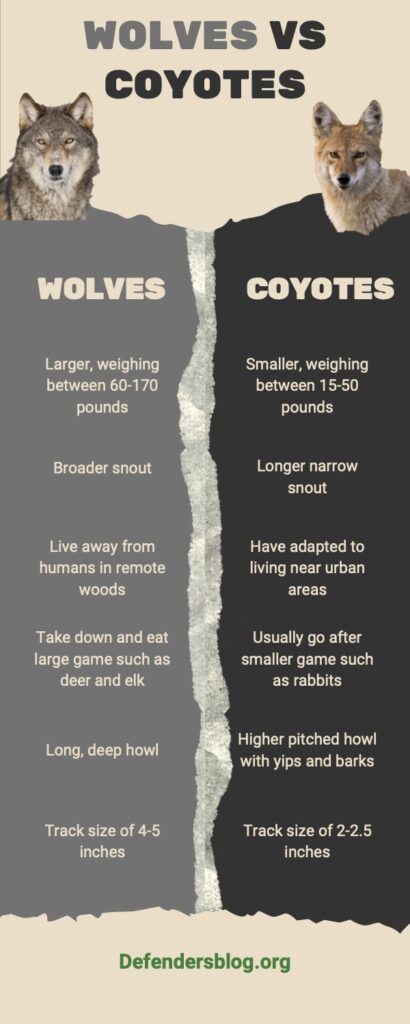
Let’s compare coyotes and wolves in a little more detail.
Size

The overall size of wolves tends to be much larger than coyotes. While some male wolves can weigh more than 150 pounds, coyotes are much smaller, usually weighing less than 60 pounds. Wolf tracks can be distinguished from coyote tracks by the size as well. A coyote track will be around 2.5 inches while a wolf track will be 4 to 5 inches.

The largest wolf ever recorded was in 1939. It was trapped in Alaska and weighed an impressive 175 pounds. There have surely been wolves that have grown larger than this but with protections put in place over the years and hunting and trapping restrictions, not as many wolves have been recorded.
Other physical characteristics
When it comes to seeing pictures of coyotes compared to wolves, many people will think they look very similar, and they do share many similarities. With that being said, they also have differences that we should point out.
A coyote will be smaller in size but will have longer legs in proportion to their body than wolves. Coyotes can almost look a little lanky compared to wolves. Wolves will be broader shouldered with a shorter, broader snout. A coyote’s snout will be long and thin with a smaller nose pad.
The ears on wolves will look slightly different than coyotes as well. A wolf will have wide, rounded ears, while a coyote will have tall, pointed ears.
Diet
You may think that wolves and coyotes surely share the same eating habits since they are so similar. While they do have some crossover in their diets, they also have some major differences.
Coyotes are omnivores, which means they eat both plants and meat. They will typically go after small game animals such as rabbits, rodents, pheasants, and fawns. Coyotes living near farms or ranches will even go after small livestock such as calves, piglets, and poultry. Coyotes will also eat carrion (dead animals), typically roadkill or prey killed by other predators. Coyotes will also eat a variety of berries and other fruit and even insects.
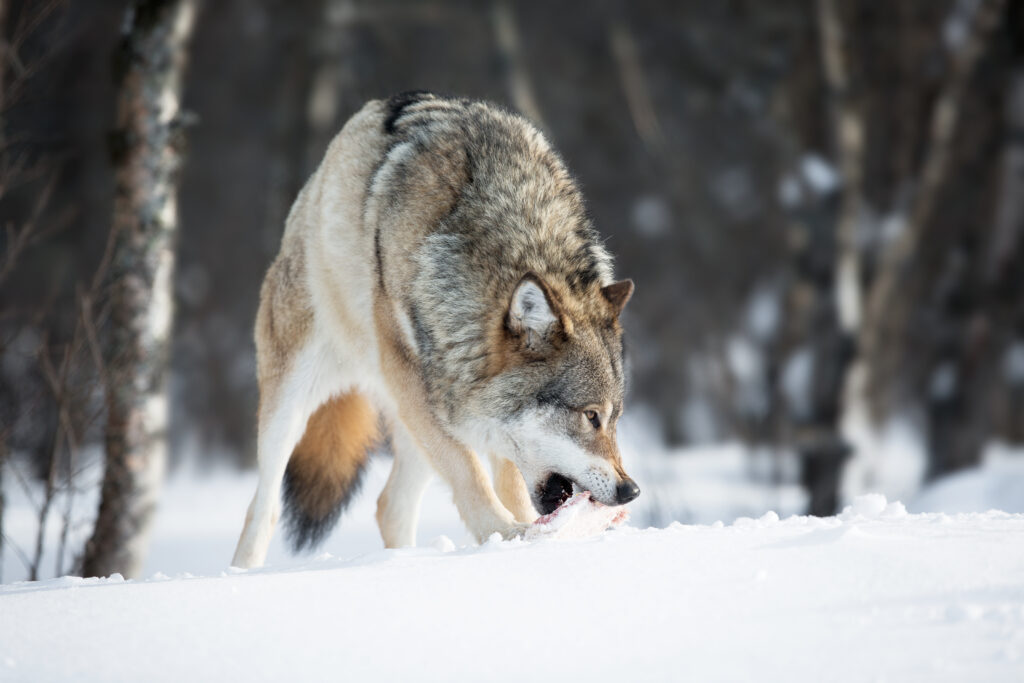
Wolves on the other hand are carnivores, which means they eat strictly meat. While wolves will go after smaller game like coyotes do, they will typically go after much larger game. This includes elk, bison, moose, and deer. Some wolves have also been known to go after cattle, which can become a problem for ranchers.
Habitat and Range
While wolves once roamed many parts of the United States, they can now only be found in several concentrated areas with the largest populations being in the northern Rockies. Coyotes on the other hand can be found throughout the entire country and have adapted well to living near urban settings.
Wolves tend to avoid human presence and live in more remote areas. They may be limited on habitat by the game animals that they pursue for food. If an area doesn’t have adequate food source, then the wolf pack will be forced to find a new area.
Coyotes will live anywhere from remote regions to right in your backyard. They have adapted to living close to human presence and some even depend on it now. It is not uncommon for you to see a coyote close to cities, and being scavengers, they can find food almost anywhere.
Social Habits
Wolves are pack animals and depend heavily on working together, especially when it comes to taking down large game for food. A wolf pack will usually consist of a dominant breeding pair of wolves and their offspring. It can also include other extended family members and even others from outside the family.

Wolves are very social amongst their pack and have rules when it comes to the order of command. When the pack makes a kill the dominant male and female are the first to start eating. In a pack there are a variety of different ages of wolves, and they care for each other. They all look after the elder wolves in the pack and help teach the young pups.
Coyotes can also be considered a social animal, but don’t necessarily form packs as much as just live amongst their family. Coyotes will typically hunt alone, not needing a pack to take down the smaller prey they typically go after. Occasionally they may go out hunting together, but it isn’t a regular occurrence. One fascinating thing about coyotes is that they have been known to hunt using other animals for help. One example of this is coyotes following groups of crows to find carrion to eat.
Howls
Another difference between coyotes and wolves is the sound of their howls. Wolves have an almost haunting howl. It’s a deep, long howl. Coyotes have a higher pitched howl and will include yips and barks much of the time as well. A neat fact about wolves is that every wolf has a unique howl that can make it easy for them to tell each other apart.
Final Thoughts
If you’re unfamiliar with coyotes and wolves, then it can be difficult to know which one you’re looking at. Although they are similar in ways, they are also very different. They are close relatives to each other, but they have different physical characteristics as well as differences in their diet and habitat. Hopefully after reading this article, you are better equipped to tell the difference between a coyote and a wolf the next time you come across one.
- Why are skunks called polecats? - November 16, 2022
- Do Armadillos lay eggs? - November 16, 2022
- Can animals have down syndrome? - October 5, 2022


